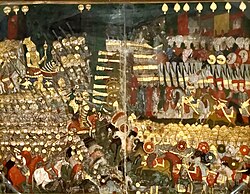摩哈赤战役
| 摩哈赤战役 | |||||||
|---|---|---|---|---|---|---|---|
 摩哈赤战役画像 | |||||||
| |||||||
| 参战方 | |||||||
|
| |||||||
| 指挥官与领导者 | |||||||
|
|
| ||||||
| 兵力 | |||||||
|
50,000-100,000人[1][2][3] 300门火炮 |
25,000–40,000人[2][3][4] 50门火炮 | ||||||
| 伤亡与损失 | |||||||
| 不详但惨重,1,500-2,000新军伤亡[5][6] |
-24,000[9]死亡 2,000名被处决的俘虏[10] | ||||||
摩哈赤战役(匈牙利语:mohácsi csata 或 mohácsi vész、土耳其语:Mohaç Savaşı 或 Mohaç Meydan Savaşı)发生于1526年8月29日,是土耳其第一次入侵匈牙利的战役。战役双方为拉约什二世率领的匈牙利王国军队及由苏莱曼一世率领的鄂图曼军队。
准备工作
[编辑]匈牙利已经长期对抗鄂图曼帝国于南欧的扩张。匈牙利国王拉约什二世透过于1521年与奥地利的玛丽联姻令王国与哈布斯堡王朝关系更加密切,而鄂图曼帝国也知道必需打破这个初期的联盟;在拉约什二世拒绝维持和平的提议之后,鄂图曼帝国决意出兵干预。在1526年6月,一支鄂图曼远征军越过多瑙河攻击匈牙利本土。
匈牙利军队被分成三个主要部分:川西凡尼亚军团负责守卫喀尔巴阡山脉南部的关口,而军队主力由国王拉约什二世亲自指挥,而其它较小规模的军团则由克罗地亚伯爵克里斯托夫·法兰高宾(Christopher Frankopan)指挥。由于王国地理位置的关系,土耳其军队直至在度过巴尔干山脉的时候才确定最后的攻击目标是王国首都。但在这时候川西凡尼亚军团比土耳其军队离开布达(现布达佩斯市西部城区,当时匈牙利王国首都)更远。之后有文献指出因特兰西瓦尼亚总督扎波尧伊·亚诺什的军队未能及时抵达,所以必须承担部分失利的责任。
匈牙利军队所选择的战场是多瑙河下游一片广阔但崎岖的平原,包括一些沼泽地。鄂图曼军队之前几乎没有遇上任何抵抗。当拉约什二世于布达等待开战的时候,鄂图曼军队已经围攻数个城镇并越过萨瓦河及德拉瓦河。拉约什二世集合了大约26,000名士兵,而当时鄂图曼一方所集结兵力,保守估算是50,000人[2][3],另据考究现代的史学家们则认为其兵力当时达到了100,000人[10][11][12][13][14][15][16]。鄂图曼一方在战前征召的巴尔干军团,据载大部分是波士尼亚人或克罗地亚人[17]。匈牙利军队列好阵势,希望凭借地理优势获得这场战争的胜利。
战斗
[编辑]真正的战斗只进行了两小时。起初苏莱曼一世的军队先锋,鲁米利亚军团,行进到战场之内,被由柏尔·杜蒙尼(Pál Tomori)所率领的匈牙利军队伏击后重创,战局并向匈牙利军队预计的情况发展,随后匈牙利军队乘胜追击直扑苏丹的指挥部。有一段时间苏莱曼一世自己非常危险,匈牙利军队的箭击中了他的盔甲,最后由于新军的枪炮火力网、大量的障碍物以及大量的征招兵的自杀攻击才成功稳住阵脚。但当奥斯曼军队主力于中午抵达后,战局迅速逆转由于未有及时增援,所以延误战机,匈牙利军队的进攻变成不能挽回的溃散。他们未能持续进攻,那些未有逃走的士兵被杀和俘虏。未能赶上首波攻势的匈牙利国土佣仆部队则拒绝投降,并在重创土耳其军队后全军覆没。据信拉约什二世是于黎明时分撤离战场,但在跨越切莱流河(匈牙利语:Csele-patak)时跌下马,被身披重甲拖累而溺亡。另外也有近千名匈牙利贵族及领战者被杀,大致相信有超过14,000名匈牙利士兵在战事开初阵亡[7][8]。
战后
[编辑]
皇家匈牙利 特兰西瓦尼亚
鄂图曼帝国 哈布斯堡奥地利

战后,苏莱曼一世下令将战俘全数灭口。两日后他于他的日记中写到:“苏丹得到大臣及酋长们的效忠,屠杀2,000名战俘,大雨如注。”[来源请求]
这次胜利并未令鄂图曼帝国得到想要的自身安全。战争意味着独立的匈牙利王国灭亡,但鄂图曼军队于九月撤退,匈牙利王国剩余领土被拉约什二世的妻舅,哈布斯堡王朝的奥地利大公斐迪南夺取,并透过与上任匈牙利及波希米亚国王乌拉斯洛二世签订的条约继承这片土地。奥地利控制匈牙利北部三分一土地和现今的克罗地亚北部,而鄂图曼帝国则得到匈牙利西南部和半独立的,由原总督扎波尧伊·亚诺什(他受到国内小贵族支持加冕为王,称亚诺什一世)统治特兰西瓦尼亚的宗主权,利用这些据点入侵东面仍然独立的匈牙利贵族及西北面的奥地利领地,后来更导致1529年鄂图曼军队围攻维也纳,是为维也纳之围。

这场战役有时会与14世纪发生的尼科波利斯战役和克雷西会战比较,协同作战能力相对较差的匈牙利军队普遍受到较大损失,但纪律性较强的鄂图曼军队则较少损失。
对于在东欧得到这个稳当的基地,鄂图曼军队强大的重骑兵、有效率的轻骑兵及火炮将能不断对中欧进攻整整一个世纪。它们对匈牙利的影响,始于1529年鄂图曼帝国支持扎波尧伊·亚诺什(拥有匈国东部的特兰西瓦尼亚)对抗斐迪南(拥有匈国西部),直至1699年鄂图曼帝国对奥地利签订卡尔洛夫奇条约,割让匈牙利为止。
于摩哈赤的失败对很多匈牙利人来说是决定性的,是匈牙利日趋没落的历史转折点,并成为了匈牙利民族的一个创伤。对于这个日子,直至400年后的今日都仍然提醒匈牙利民族他们对于任何困境都仍然坚毅不屈。现时匈牙利人一旦遇上困境,他们都会说“在摩哈赤所失去的远比现时的多”(匈牙利语:Több is veszett Mohácsnál),借此勉励自己面对困难。

参考书目
[编辑]- Lord Kinross, The Ottoman Centuries: The Rise and Fall of the Turkish Empire (1977) ISBN 0-688-08093-6
参考资料
[编辑]- ^ Ágoston, Gábor. Mohács, Battle of. Ágoston, Gábor; Bruce Masters (编). Encyclopedia of the Ottoman Empire
 . New York: Facts on File. 2009: 388–389.
. New York: Facts on File. 2009: 388–389.
- ^ 2.0 2.1 2.2 Stavrianos, Balkans Since 1453, p. 26 "The latter group prevailed, and on 29 August 1526 the fateful battle of Mohacs was fought: 25,000 to 30,000 Hungarians and assorted allies on the one side, and on the other 45,000 Turkish regulars supported by 10,000 lightly armed irregulars."
- ^ 3.0 3.1 3.2 Nicolle, David, Hungary and the fall of Eastern Europe, 1000–1568, p. 13 "Hungary mustered some 25,000 men and 85 bore cannons (only 53 being used in actual battle), while for various reasons the troops from Transylvania and Croatia failed to arrive.
- ^ Feridun Emecen,Battle of Mohacs. [2022-02-09]. (原始内容存档于2022-02-20). (in Turkish)
- ^ Cathal J. Nolan, The Age of Wars of Religion, 1000–1650: An Encyclopedia of Global Warfare and Civilization, Vol. 2, (Greenwood Press, 2006), 602.
- ^ Battle of Mohacs | Summary. [2022-02-09]. (原始内容存档于2015-05-03).
- ^ 7.0 7.1 Turner & Corvisier & Childs, A Dictionary of Military History and the Art of War, pp. 365–366 "In 1526, at the battle of Mohács, the Hungarian army was destroyed by the Turks. King Louis II died, along with 7 bishops, 28 barons and most of his army (4,000 cavalry and 10,000 infantry)."
- ^ 8.0 8.1 Minahan, One Europe, many nations: a historical dictionary of European national groups, p. 311 "A peasant uprising, crushed in 1514, was followed by defeat by the Ottoman Turks at the battle of Mohacs in 1526. King Louis II and more than 20,000 of his men perished in battle, which marked the end of Hungarian power in Central Europe."
- ^ Feridun Emecen,Battle of Mohacs. [2022-02-09]. (原始内容存档于2022-02-20). "According to the rûznâme kept during the battle, the Hungarian dead who remained in the square were not left in the middle and were buried, while the bodies of 20,000 infantry and 4,000 cavalry were counted." (in Turkish)
- ^ 10.0 10.1 Spencer Tucker Battles That Changed History: An Encyclopedia of World Conflict, p. 166 (published 2010)
- ^ Gábor Ágoston,Bruce Alan Masters: Encyclopedia of the Ottoman Empire, p. 583 (published: 2009
- ^ Christian P. Potholm: Winning at war: seven keys to military victory throughout history, p. 117 (published in 2009)
- ^ William J. Duiker, Jackson J. Spielvogel: World History, Volume: I p. 419, (published: 2006)
- ^ Stanley Lane-Poole: Turkey, p. 179 (published 2004)
- ^ Stephen Turnbull: The Ottoman Empire, 1326–1699, p. 46
- ^ Battle of Mohács article (页面存档备份,存于互联网档案馆) Encyclopædia Britannica
- ^ Fine, John V. A. When Ethnicity Did Not Matter in the Balkans: A Study of Identity in Pre-Nationalist Croatia, Dalmatia, and Slavonia in the Medieval and Early-Modern Periods. University of Michigan Press. 2010: 215. ISBN 978-0472025602.
延伸阅读
[编辑]- Stavrianos, L.S. Balkans Since 1453, C. Hurst & Co. Publishers, 2000.
- Nicolle, David, Hungary and the fall of Eastern Europe, 1000–1568, Osprey Publishing, 1988.
- Stephen Turnbull, The Ottoman Empire 1326–1699, Osprey Publishing, 2003.
- Molnár, Miklós, A Concise History of Hungary, Cambridge University Press, 2001.
- Minahan, James B. One Europe, many nations: a historical dictionary of European national groups, Greenwood Press, 2000.
- Palffy, Geza. The Kingdom of Hungary and the Habsburg Monarchy in the Sixteenth Century (East European Monographs, distributed by Columbia University Press, 2010) 406 pages; Covers the period after the battle of Mohacs in 1526 when the Kingdom of Hungary was partitioned in three, with one segment going to the Habsburgs.
- History Foundation, Improvement of Balkan History Textbooks Project Reports (2001) ISBN 975-7306-91-6

